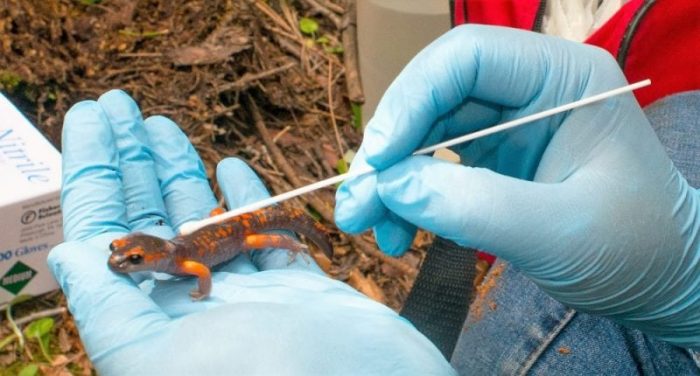
For most people, amphibians (e.g. frogs and salamanders) are not a part of everyday life. They tend to be cryptic in both form and behavior and are therefore somewhat hard to come across. But amphibians play a significant role in the ecology of many ecosystems. Herpetologists have been studying the ecology and evolution of these animals for a long time, but recent technological advancements have opened up a new branch of amphibian research, about which little is known – namely, the microbiome.
The study of whole microbial communities using DNA sequencing, or microbiomics, is a rapidly growing scientific field. In humans, the microbial community living within us has been shown to affect health, disease, and behavior, and can even reveal clues about our past (both recent, and ancient). The microbiome likely plays an important role in the lives of amphibians and other animals as well, but we are just beginning to understand its function.
For amphibians, the main focus of current microbiomic research is the skin. Unlike mammals or reptiles, amphibians don’t have the protective structures of hair, fur, or feathers, and are therefore in direct contact with their environment. Amphibians exchange water, salts, and gases directly through the skin. In addition, the skin is the first line of defense against many pathogens, including emerging infectious diseases such as the devastating fungal chytridiomycosis. We know that microbial communities of microbes living on amphibian skin are diverse, but we still don’t fully understand what shapes them. Are they driven by the host’s physiology? Their habitat? Their history?
We addressed these questions using a case study of a Californian salamander, the yellow-eyed Ensatina (Ensatina eschscholtzii xanthoptica). This salamander has a disjunct range which includes the San Francisco Bay Area as well as the western lowlands of the Sierra Nevada mountains. The population in the Sierra Nevada was split from the other populations about 15,000 years ago, while those in the Bay Area were split more recently. Such a scenario provides a good “natural experiment” to test whether the skin microbiome follows the same pattern as the host’s bioegeographic history, or is instead determined by habitat or host physiology. If the Sierra Nevada population’s skin microbiomes are the most dissimilar to the other populations, such a pattern would suggest that the microbial community diverges in the same pattern as the host. If instead skin communities are similar across distant populations, this would suggest that the microbiome is relatively conserved across space and time.
We, therefore, sampled individuals from each of four populations, one in the Sierra Nevada foothills and three in the Bay Area. Whenever we found a salamander, we would also collect a soil sample, which served as a representation of the available microbiome present in the habitat. We also included males, females, and juveniles in our study to test whether host physiology (either sex or development) impacts the microbiome.
How Salamander Population History Impacts Microbial Communities

Swabbing a salamander to sample the skin microbiome (Photo by Brian Freiermuth)
What we found was rather surprising. We had expected that the microbiome would diverge in the same way as the host populations, such that the most distantly related salamander populations would have the most dissimilar microbiomes. However, we found instead that two of the most distinct populations actually had the most similar skin microbial communities! The population history of the salamanders themselves did not seem to affect the microbial community, suggesting that the relationship between the salamanders and their microbiomes has been relatively conserved. However, that being said, each population did have its own set of unique bacterial species. While these unique species did not dominate the microbiomes, they show that the microbial communities of these four populations are not identical, and are therefore not entirely driven by the host species’ identity.
Similarly, habitat did not have a great impact on the salamander microbiomes either; salamanders microbiomes were distinct from their respective habitat samples. Interestingly, salamanders and soil microbiomes did share a number of common microbial species, but the communities were dominated by different ones. Overall, salamander microbiomes from all populations were more similar to each other than to the soil, suggesting that despite their differences, they were still relatively conserved compared to the available microbes present in the habitat.
In addition to geographic differences, we also tested for the effects of two salamander traits – sex and age – on the microbiome. Like in many animal species, females and males of Ensatina behave differently. Males tend to move around more looking for mates, while females tend to stay put. In addition, Ensatina use pheronomonal cues to communicate. We thought these physiological and behavioral differences might lead to differences in microbiome composition between the sexes. We were also interested in whether the microbiome might change with age. As salamanders grow up, their physiology shifts and their immune systems mature, which we predicted might have an impact on microbiome composition.
Interestingly, we found no difference in the microbiome between males and females. Apparently, the behavioral and physiological differences between the sexes don’t impact the microbial community composition. Our results regarding age were somewhat ambiguous – juvenile salamanders had slightly different microbiomes than adults, but the differences were quite small. Overall, it appears that the age and sex do not have a strong impact on the microbiome, which is somewhat surprising and contradicts patterns found in other species of animals, including other amphibians.
In all, our study found that the yellow-eyed Ensatina skin microbiome is impacted by both the host and by the environment. Luckily, the field of amphibian microbiome research is an active one, and new information from a diverse set of amphibian species will no doubt help clarify the patterns and processes involved in amphibian skin microbial ecology.
These findings are described in the recently published article entitled Intraspecific Variation in the Skin-Associated Microbiome of a Terrestrial Salamander, in the journal Microbial Ecology. This work was led by Sofia Prado-Irwin at San Francisco State University.









